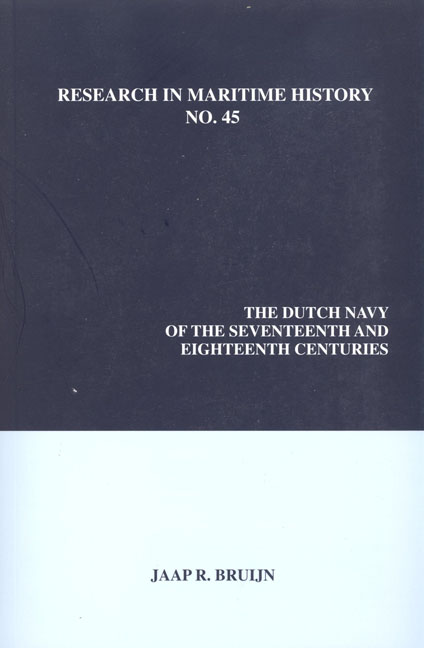Book contents
- Frontmatter
- Contents
- Illustrations
- Tables
- Series Editor's Foreword
- About the Author
- Introduction to the 2011 Edition
- Foreword
- Preface
- Introduction
- Map of the Dutch Republic
- Map of Dutch Naval Activity in European Waters
- Part One The “Old” Navy, Late 1500s-1652
- Naval Operations against Spain and the Dunkirk Privateers
- The Boards of the Admiralties at Work
- The Slow Birth of a Naval Officers' Corps
- Truly International Crews
- Part Two The “New” Navy, 1652-1713
- Part Three A Second-Rate Navy, 1714-1795
- In Retrospect
- Bibliography
- Index
The Slow Birth of a Naval Officers' Corps
from Part One - The “Old” Navy, Late 1500s-1652
- Frontmatter
- Contents
- Illustrations
- Tables
- Series Editor's Foreword
- About the Author
- Introduction to the 2011 Edition
- Foreword
- Preface
- Introduction
- Map of the Dutch Republic
- Map of Dutch Naval Activity in European Waters
- Part One The “Old” Navy, Late 1500s-1652
- Naval Operations against Spain and the Dunkirk Privateers
- The Boards of the Admiralties at Work
- The Slow Birth of a Naval Officers' Corps
- Truly International Crews
- Part Two The “New” Navy, 1652-1713
- Part Three A Second-Rate Navy, 1714-1795
- In Retrospect
- Bibliography
- Index
Summary
A few hundred naval officers served the admiralties at any one time. Little has been written about them as a group, and only a few biographical works about the most famous ones exist. The ordinary officer is not known at all, and even the image of the average naval captain remains vague.
No special training or education was required to become a naval officer. Candidates were supposed to be qualified to belong to the captain's staff and to supervise and give orders to the crew via the petty officers. It is hard to separate the reasons why one young man might become an officer and another only an ordinary seaman. Social background or sometimes a natural aptitude for leadership was usually the determining factor for selection into the officer class. During the period of the “old navy,” the officers’ ranks were not actually closed to men from the lower strata of society, but they were always wide open to those from the higher classes. And the mixture of ship types - real men-of-war, hired merchantmen and the so-called “directieschepen” - with their different kinds of officers confuses the picture even more.
Since the days of the Sea Beggars (c. 1570), it had not been uncommon for noblemen to command warships. At least one-quarter of the Sea Beggars’ captains belonged to the nobility, most of them having taken refuge among the Sea Beggars to escape Spanish religious persecution. This was also true of an almost equal number of merchants and high officials. Part of them continued their new seafaring occupation and may have set the trend for other generations of noblemen and sons of upper-class burghers to enter into a naval career. Warfare at sea was considered mainly a military affair, in which a “soldier” should command, not a “seaman.” Such “soldier” commanders were advised by ships’ masters and mates on aspects of navigation. The nobility enjoyed a natural superiority over subordinate officers and crew.
Sea Beggar captain Willem Bloys van Treslong (c. 1529-1594) had served in the navy of Charles V and Philip II of Spain. Born at Brielle into the lower nobility, he distinguished himself in 1571 and 1572 and was appointed lieutenant admiral of Holland in 1573 and, three years later, of Zeeland, becoming the prototype of the flag officer of future decades.
- Type
- Chapter
- Information
- Publisher: Liverpool University PressPrint publication year: 2011

